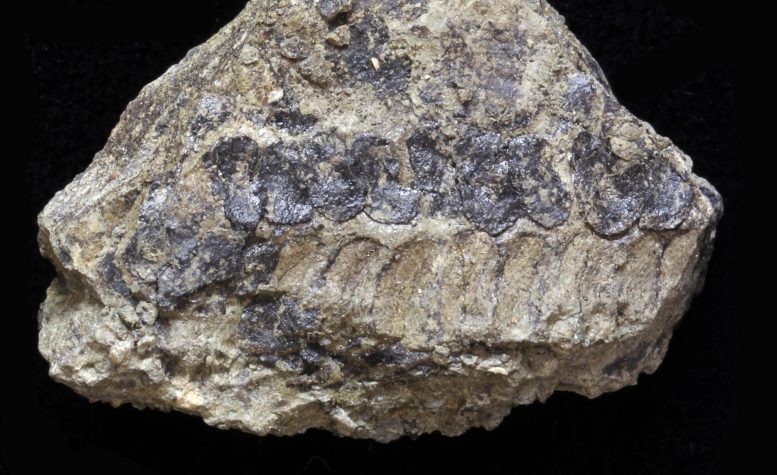
Researchers have discovered an ancient plant species whose reproductive biology captures the evolution from one to two spore sizes – an essential transition to the success of the seed and flowering plants we depend on.
In a brilliant dance, a cornucopia of flowers, pinecones, and acorns connected by wind, rain, insects and animals ensure the reproductive future of seed plants. But before plants achieved these elaborate specializations for sex, they went through millions of years of evolution. Now, researchers have captured a glimpse of that evolutionary process with the discovery of a new ancient plant species.
The fossilized specimen likely belongs to the herbaceous barinophytes, an unusual extinct group of plants that may be related to clubmosses, and is one of the most comprehensive examples of a seemingly intermediate stage of plant reproductive biology. The new species, which is about 400 million years old and from the Early Devonian period, produced a spectrum of spore sizes – a precursor to the specialized strategies of land plants that span the world’s habitats. The research was published in Current Biology on May 4, 2020.
“Usually when we see heterosporous plants appear in the fossil record, they just sort of pop into existence,” said the study’s senior author, Andrew Leslie, an assistant professor of geological sciences at Stanford’s School of Earth, Energy & Environmental Sciences (Stanford Earth). “We think this may be kind of a snapshot of this very rarely witnessed transition period in evolutionary history where you see high variation amongst spores in the reproductive structure.”
A major shift
One of the most important time periods for the evolution of land plants, the Devonian witnessed diversification from small mosses to towering complex forests. The development of different spore sizes, or heterospory, represents a major modification to control reproduction – a feature that later evolved into small and large versions of these reproductive units.
“Think of all the different types of sexual systems that are in flowers – all of that is predicated on having separate small spores, or pollen, and big spores, which are inside the seeds,” Leslie said. “With two discrete size classes, it’s a more efficient way of packaging resources because the big spores can’t move as easily as the little ones, but can better nourish offspring.”
The earliest plants, from between 475 million to 400 million years ago, lacked reproductive specialization in the sense that they made the same types of spores, which would then grow into little plantlets that actually transferred reproductive cells. By partitioning reproductive resources, plants assumed more control over reproduction, according to the researchers.
The new species, together with the previously described plant group Chaleuria of the same age, represents the first evidence of more advanced reproductive biology in land plants. The next example doesn’t appear in the fossil record until about 20 million years later.
“These kinds of fossils help us locate when and how exactly plants achieved that kind of partitioning of their reproductive resources,” Leslie said. “The very end of that evolutionary history of specialization is something like a flower.”
A fortuitous find
The researchers began analyses of the fossils after they had been stored in the collections at the Smithsonian National Museum of Natural History for decades. From about 30 small chips of rock originally excavated from the Campbellton Formation of New Brunswick in Canada by late paleobotanist and study co-author Francis Hueber, they identified more than 80 reproductive structures, or sporangia. The spores themselves range from about 70 to 200 microns in diameter – about a strand to two strands of hair. While some of the structures contained exclusively large or small spores, others held only intermediate-sized spores and others held the entire range of spore sizes – possibly with some producing sperm and others eggs.
“It’s rare to get this many sporangia with well-preserved spores that you can measure,” Leslie said. “We just kind of got lucky in how they were preserved.”
Fossil and modern heterosporous plants primarily live in wetland environments, such as floodplains and swamps, where fertilization of large spores is most effective. The ancient species, which will be formally described in a follow-up paper, has a medley of spores that is not like anything living today, Leslie said.
“The overarching story in land plant reproduction is one of increased division of labor and specialization and complexity, but that has to begin somewhere – and it began with simply producing small spores and big spores,” Leslie said. “With these kinds of fossils, we can identify some ways the plants were able to do that.”
Reference: “A novel reproductive strategy in an Early Devonian plant” by Nikole K. Bonacorsi, Patricia G. Gensel, Francis M. Hueber, Charles H. Wellman and Andrew B. Leslie, 4 May 2020, Current Biology.
DOI: 10.1016/j.cub.2020.03.040
Co-authors of the study are from Brown University, the University of North Carolina – Chapel Hill and the University of Sheffield.
Never miss a breakthrough: Join the SciTechDaily newsletter.